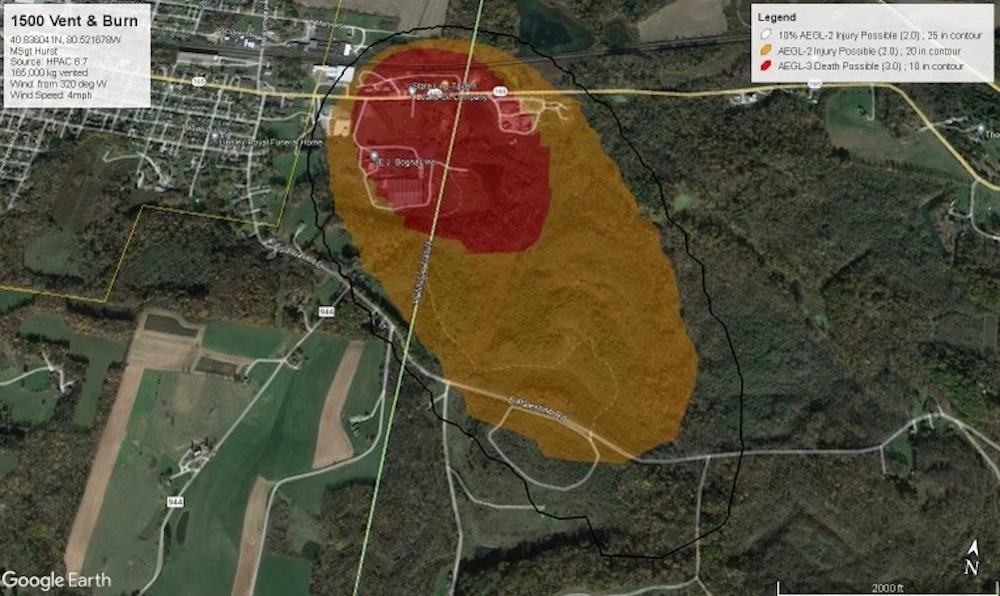Lingering Effects: Toxic Chemical Contamination From Ohio Train Derailment

Table of Contents
Environmental Contamination and its Long-Term Impacts
The release of toxic chemicals has resulted in widespread environmental contamination with potentially devastating long-term effects.
Soil and Water Contamination
The types of chemicals released, notably vinyl chloride, a known carcinogen, and butyl acrylate, a volatile organic compound, readily penetrate soil and contaminate groundwater. These chemicals are persistent in the environment, meaning they don't easily break down, posing a significant risk of long-term groundwater contamination. This contamination can have devastating effects on local ecosystems, impacting drinking water supplies and harming wildlife for years to come.
- Affected wildlife: Studies are underway to assess the impact on fish, amphibians, and other animals that rely on the contaminated water sources. Bioaccumulation – the process where toxins accumulate in the tissues of organisms – is a significant concern, potentially leading to higher concentrations in the food chain.
- Long-term remediation challenges: Cleaning up contaminated soil and water is a complex and expensive process that could take years, if not decades. The extent of the contamination and the depth of affected groundwater remain to be fully assessed.
Air Quality and Respiratory Issues
The immediate aftermath saw a plume of toxic smoke billowing from the burning chemicals, significantly impacting air quality. Inhaling these chemicals can lead to a range of immediate and long-term respiratory problems.
- Long-term respiratory illnesses: Exposure to vinyl chloride and other released chemicals is linked to an increased risk of chronic obstructive pulmonary disease (COPD), asthma, and other respiratory illnesses. Long-term monitoring of respiratory health in the affected population is crucial.
- Specific respiratory illnesses: Reports of acute respiratory symptoms, such as coughing, shortness of breath, and wheezing, were prevalent immediately after the derailment. However, the long-term effects on lung function require continuous monitoring and study.
Impact on Agriculture and Food Security
The chemical contamination poses a significant threat to agriculture and food security in the region. Contaminated soil can render agricultural land unusable, and the potential for chemical contamination of food crops raises serious concerns.
- Potential for crop failure: If the contamination reaches agricultural fields, it could lead to crop failure, impacting farmers' livelihoods and food supplies.
- Livestock health concerns: Exposure to contaminated water or feed could affect the health of livestock, leading to decreased productivity and potential food safety issues.
- Long-term economic impacts: The economic consequences for farmers in the affected area could be severe and long-lasting.
Public Health Concerns and Long-Term Effects
The Ohio train derailment has raised significant public health concerns, with both immediate and long-term health risks.
Immediate Health Impacts
Residents reported a wide range of immediate health issues following the derailment, including headaches, nausea, vomiting, eye irritation, and respiratory problems. The sheer number of people experiencing symptoms underscored the severity of the chemical exposure.
- Specific symptoms reported: Detailed symptom tracking and data collection are vital for understanding the full spectrum of immediate health effects.
- Challenges in diagnosing long-term issues: The latency period for certain health effects, meaning the time between exposure and the manifestation of symptoms, can be long, making accurate diagnosis and attribution to the derailment challenging.
Long-Term Health Risks
The long-term health consequences of exposure to the released chemicals are a major concern. There's a significant risk of developing cancer, reproductive issues, and developmental problems, particularly in children.
- Types of cancer linked to chemical exposure: Vinyl chloride, for example, is a known human carcinogen linked to several types of cancer.
- Potential developmental effects: Exposure to these chemicals during pregnancy or early childhood can have severe consequences for a child's development.
- Need for long-term epidemiological studies: Comprehensive, long-term epidemiological studies are needed to fully understand the health impacts of this disaster.
Psychological Impacts
Beyond physical health concerns, the derailment has caused significant psychological trauma among residents. The stress and anxiety associated with living in a contaminated area cannot be underestimated.
- Specific mental health issues: Increased rates of anxiety, depression, PTSD, and other mental health issues are expected in the affected community.
- Access to mental health services: Ensuring access to adequate mental health services and support is crucial for the long-term well-being of the community.
Government Response and Accountability
The initial government response to the derailment faced criticism, with concerns raised about the speed and effectiveness of the cleanup efforts and communication with residents.
- Government agencies involved: Multiple agencies, including the EPA and the NTSB, are involved in the investigation and cleanup, but coordination and transparency remain critical.
- Criticisms of the response: Concerns surround the controlled burn of vinyl chloride and the initial evacuation orders. Transparency and clear communication are essential to rebuild trust.
- Ongoing investigations: Investigations into the cause of the derailment and the adequacy of the regulatory oversight are underway.
- Legal actions: Lawsuits against the railroad company and other responsible parties are likely.
Conclusion: Addressing the Lingering Effects of Toxic Chemical Contamination
The long-term effects of the Ohio train derailment are profound and far-reaching, impacting the environment, public health, and the affected community's well-being. The lingering effects of toxic chemical contamination demand ongoing monitoring, comprehensive research, and effective remediation efforts to mitigate the damage and support the affected community's recovery. The lingering effects of this disaster demand our continued attention. Stay informed, support affected communities, and demand accountability to ensure a safer future and address the long-term consequences of this devastating event.

Featured Posts
-
 Live Streaming Moto Gp Inggris 2025 Sprint Race Nonton Online Pukul 20 00 Wib
May 26, 2025
Live Streaming Moto Gp Inggris 2025 Sprint Race Nonton Online Pukul 20 00 Wib
May 26, 2025 -
 Disparition De La Semaine Des 5 Heures La Rtbf S Explique
May 26, 2025
Disparition De La Semaine Des 5 Heures La Rtbf S Explique
May 26, 2025 -
 Claire Williams And George Russell A Controversial Relationship
May 26, 2025
Claire Williams And George Russell A Controversial Relationship
May 26, 2025 -
 Beyond Bmw And Porsche The Broader Challenges In The Chinese Auto Market
May 26, 2025
Beyond Bmw And Porsche The Broader Challenges In The Chinese Auto Market
May 26, 2025 -
 Martin Compston And The Cinematic Transformation Of Glasgow
May 26, 2025
Martin Compston And The Cinematic Transformation Of Glasgow
May 26, 2025
